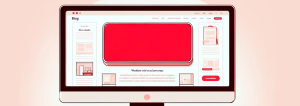If you’re running a website, monetization is likely one of your primary goals. Achieving it requires many things; but the most important is having a site that’s easy to use and makes users come back. That’s where usability testing tools come in.
By identifying usability issues, you can make improvements that will keep visitors coming back and boost your monetization efforts. But finding the right tool can be difficult.
That’s why we have created this article especially for you. Follow us through the reading and discover what is a usability test, which types exist and how to choose the right one for you!
What is a Usability Test?
A usability test refers to evaluating a website or app’s ease of use by observing real users completing tasks on them. The main goal of this process is to uncover pain points in the customer journey and user experience.
It can be done by asking users to do specific actions like creating an account or making a purchase. The key is to observe them thoroughly to spot any blockers and be prepared for honest feedback. You can watch Usability Testing in UX Design Thinking Process to learn more about it!
After applying it, you may need to go through some of the design thinking steps multiple times. But, that is okay! This will increase your chances to succeed and stay competitive.
Types of Usability Testing
Usability testing is a process that should adapt to your site’s needs and characteristics. There are different types of evaluations you can apply to test the usability of your website or mobile app. Let’s dive into some of them!
Qualitative or Quantitative
Qualitative testing requires observing users as they complete tasks and recording their feedback and opinions. This is useful for identifying user pain points and areas for improvement.
On the other hand, quantitative testing is about collecting data on user behavior and metrics. Information such as task completion rates, time on task, and error rates. This type of testing is useful for measuring the overall usability of your site.
Moderated or Unmoderated
Moderated testing involves a moderator who guides the user through tasks and asks questions about their experience. This type of testing can help you to get more detailed feedback from users.
Unmoderated testing requires users completing tasks on their own, without a moderator present. Something quite useful for collecting large amounts of data quickly and easily.
Remote or In-Person
In remote testing, users complete tasks from their own location; while in-person testing, users go to a physical location to complete these tasks.
The first one is useful for reaching a larger pool of participants and collecting data from a wider range of users. The second one can help getting more detailed feedback and observing user behavior personally.
How to Choose a Usability Testing Tool That’s Right for You

With so many different types of usability testing, it can be overwhelming to choose the right tool for your needs. So, before anything, you should know your product and your target audience. Then, you can consider the following features:
- Find remote testing capabilities. You can conduct remote usability tests with participants from all over the world. This makes it easy to collect data from a wide range of users and get a better understanding of how your site is performing across different demographics.
- Keep in mind tools for collecting qualitative and quantitative data. With its user feedback feature, you can collect detailed feedback from participants on their experience using your site. And, also, quantitative data on user behavior and metrics, such as task completion rates and time on task.
- Remember flexibility. This will allow you to conduct both moderated and unmoderated testing, as well as remote and in-person testing. This gives you the flexibility to choose the methods that are best suited to your needs and budget.
After considering those specifications, you will need to follow a few steps to help you choose a usability testing tool that’s right for you. Let’s dive into them!
- Define your UX research question(s)
Before you start looking for a usability testing tool, it’s important to define your UX research question(s). What do you want to learn from your usability testing? What specific issues are you hoping to identify?
- Decide what type of data you need to collect
Once you’ve defined your research questions, it’s important to decide what type of data you need to collect. Do you need qualitative feedback from users? Or do you need quantitative data on user behavior and metrics?
- Determine how you’ll run usability testing
The next step is to determine how you’ll run your usability testing. Will you conduct moderated or unmoderated testing? Will you conduct remote or in-person testing? By deciding how you’ll run your testing, you’ll be able to narrow down your options and choose a tool that’s compatible with your testing methods.
- Choose a usability testing tool
Finally, it’s time to choose a usability testing tool. There are many different options to choose from on the internet. Many of them are comprehensive usability testing tools that offer a variety of features and capabilities to help you improve your site’s user experience.

Conclusions
Usability testing is an essential part of improving a website’s monetization efforts. By identifying blockers and making improvements to the user experience, you can keep visitors coming back and increase your revenue.
When choosing a usability testing tool, it’s important to define your research questions, decide what type of data you need to collect, determine how you’ll run your testing, and choose a tool that’s right for your needs.
Some options you can find are comprehensive tools that offer a variety of features and capabilities to help you improve your site’s user experience. So, don’t be afraid to experiment and ensure the success of your product by using them!
Related Posts You Might Like
- Mobile App User Acquisition Strategy: Best Tips to Create One
- 5 Monetization Strategies for Your App
- How to Reach More Audience







